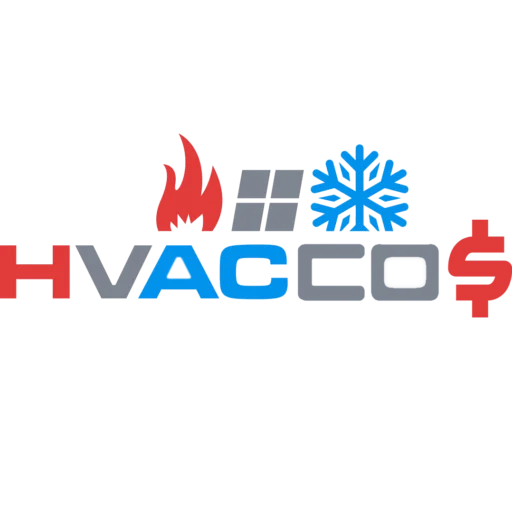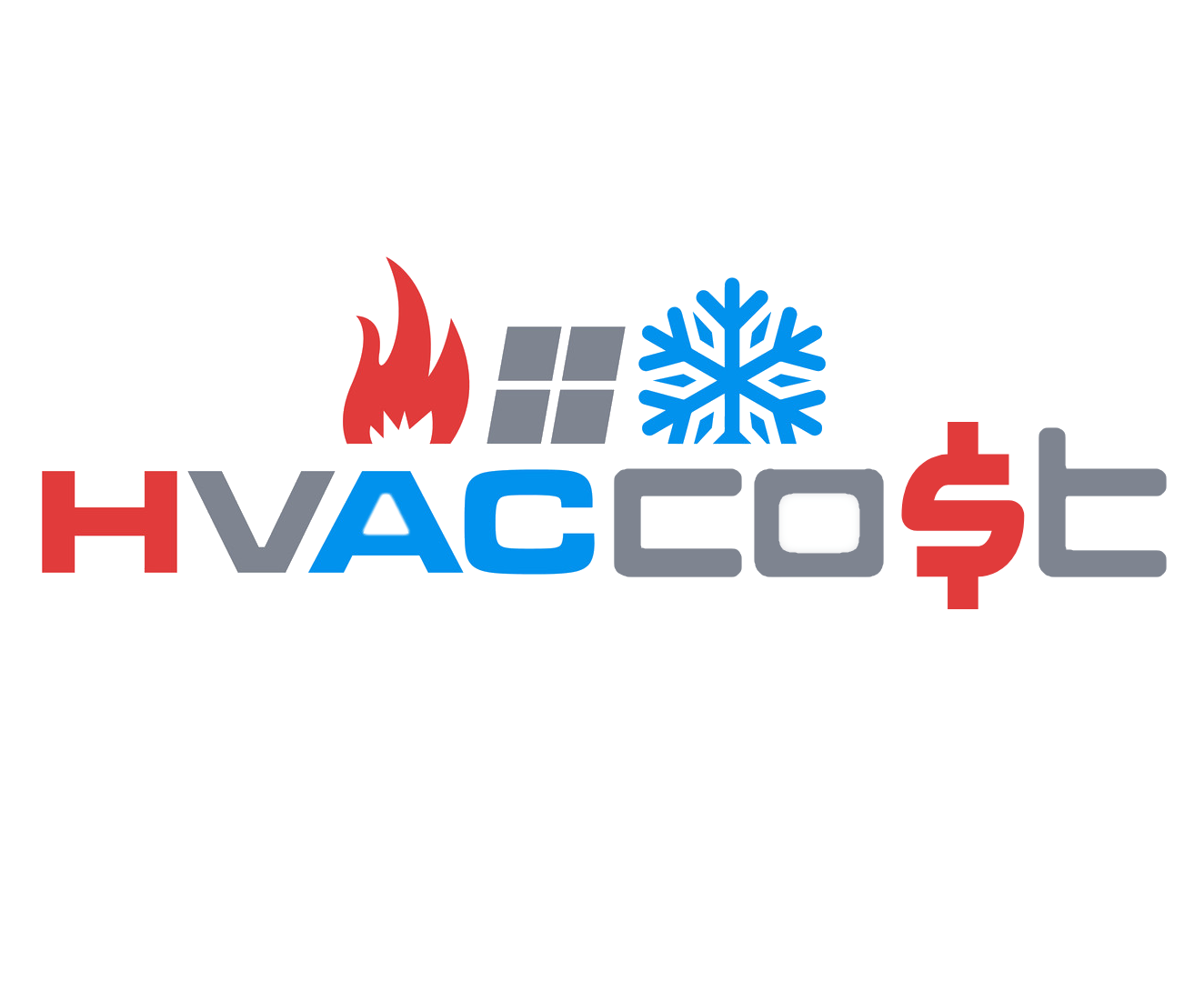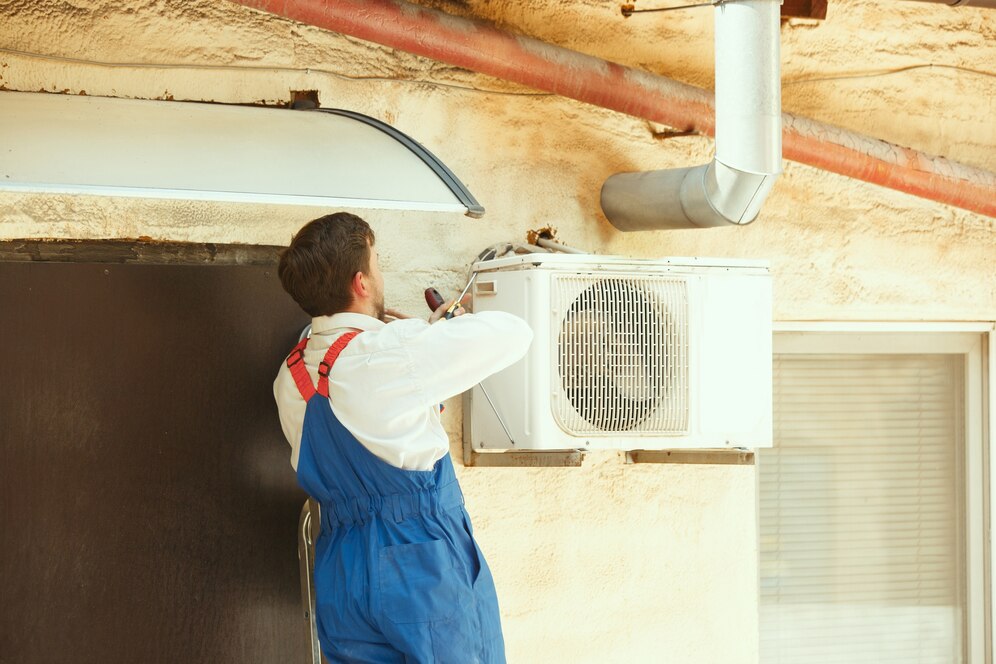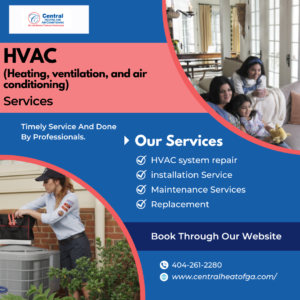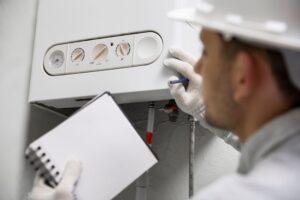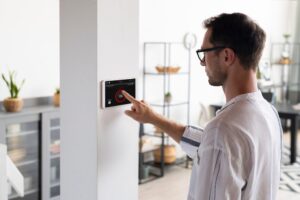The cost of installing an HVAC system in your home can significantly vary. Factors such as your home’s size, the chosen system type, and installation complexity all play a role. Typically, homeowners may spend anywhere from $5,000 to $9,000 for a standard HVAC system installation.
For basic, single-unit HVAC systems, costs might start below $4,500. In contrast, more extensive and intricate systems could exceed $15,000. Remember, these figures are averages; your actual expenses will depend on the specific system and the installer you choose.
HVAC, which stands for heating, ventilation, and air conditioning, is essential for maintaining comfortable temperature, humidity, and air quality indoors throughout the year.
Additionally, it’s important to note that many HVAC installations may qualify for government subsidies exceeding $10,000 under the Inflation Reduction Act. To explore this opportunity, contact the HVAC technicians for expert advice and to check if your new HVAC system installation could be subsidized.
Average HVAC Installation Costs
| National Average Cost | $7,500 |
| Typical Price Range | $5,000 – $9,000 |
| Extreme Low-End Cost | $4,500 |
| Extreme High-End Cost | $15,000 |
The average national expense for an HVAC system installation is around $7,500, typically ranging from $5,000 to $9,000, inclusive of professional installation fees. An HVAC contractor usually charges about $3 to $6 per square foot of your home, with the final cost varying based on installation complexity.
Several elements influence this cost, including:
- The size of your home
- The chosen HVAC system type
- The brand of the HVAC system
- Installation expenses
- Your local climate
- The dimensions and complexity of existing ductwork
- The system’s energy efficiency
On the upper scale, a new HVAC system might cost upwards of $15,000. However, for smaller spaces like apartments or condos, the cost might be closer to $4,500. In contrast, larger homes or those with multiple levels often necessitate more intricate and costly HVAC solutions.
HVAC Installation Cost Guide Based on Home Size
Typically, the cost of installing an HVAC system increases with the size of your home. A larger home not only demands more labor from the contractor but also requires more materials, contributing to higher costs. On average, homeowners can expect to pay between $3 and $6 for every square foot that needs heating and cooling.
For example, for a home measuring 1,200 square feet, the estimated installation cost would range from approximately $3,600 to $7,200. This cost variation depends on factors like the system type and the intricacies of the ductwork installation.
Below is a brief overview of the average HVAC installation costs, categorized by the square footage of homes:
| Home/Condo Size | Average Cost of Installation |
| 800 square feet | $2,400 – $4,800 |
| 1,200 square feet | $3,600 – $7,200 |
| 1,500 square feet | $4,500 – $9,000 |
| 2,000 square feet | $6,000 – $12,000 |
Understanding Residential HVAC Unit Costs by Tonnage
In HVAC terms, a “ton” refers to the cooling capacity of an air conditioning system, equivalent to the energy needed to melt 1 ton (2,000 pounds) of ice in 24 hours. Essentially, it measures how much heat the system can extract from a house in a day. Smaller homes typically require less tonnage for efficient cooling. The term BTU, or British Thermal Unit, represents this cooling capacity, where 1 ton of air conditioning equals 12,000 BTUs per hour.
*Note: 1 ton = 12,000 BTUs per hour
Take, for instance, a 1,500-square-foot home needing a 2-ton cooling capacity, which translates to 24,000 BTUs per hour. For a 2-ton AC unit, the average installation cost ranges from $2,500 to $5,000. This cost varies based on the type of system and the complexity of the installation process.
| Size | BTUs | Area (square feet) | Cost of HVAC System Installed |
| 1.5 tons | 18,000 BTU/h | 800 – 900 sq. ft. | $2,400 – $4,800 |
| 2 tons | 24,000 BTU/h | 900 – 1,500 sq. ft. | $2,500 – $5,000 |
| 3 tons | 36,000 BTU/h | 1,600 – 2,000 sq. ft. | $3,200 – $6,000 |
| 3 to 4 tons | 48,000/h BTU/h | 2,000 – 2,400 sq. ft. | $3,500 – $7,500 |
| 3.5 to 5 tons | 60,000/h BTU/h | 2,500 sq. ft. | $4,200 – $9,000 |
Cost of Residential HVAC Units Based on Efficiency
The efficiency of an HVAC system is a key factor affecting both its installation and operational costs. Central air conditioners, often combined with natural gas or propane furnaces, are a prevalent choice for residential HVAC systems. Their efficiency is gauged by the Seasonal Energy Efficiency Ratio (SEER), which reflects the amount of energy required for cooling.
A system with a SEER rating of 16, for instance, is more energy-efficient than one with a SEER of 13. Higher SEER ratings signify greater efficiency and lower energy costs, but they also come with higher initial installation costs.
The most frequently encountered SEER rating for central air conditioners is 13, the legal minimum. However, models with SEER ratings as high as 24 are available. The cost of installing a central air conditioner with a SEER of 13 typically ranges from $1,500 to $3,500. In comparison, installing a system with a SEER of 24 can cost between $4,300 and $7,500, including installation fees.
| SEER | Efficiency | Average Cost (Labor + Materials) |
| 13 – 14 | Standard-Efficiency | $1,500 – $3,500 |
| 15 -16 | High-Efficiency | $1,700 – $4,900 |
| 17 – 18 | High-Efficiency | $2,000 – $5,500 |
| 19 – 21 | Very high-Efficiency | $2,500 – $6,700 |
| 22 – 24 | Maximum-Efficiency | $4,300 – $7,500 |
Comprehensive Guide to Factors Influencing HVAC System Costs
When planning for an HVAC system installation, it’s essential to consider various elements that can affect the overall expenditure. Besides size and efficiency, numerous other factors can impact the price of your HVAC system. Here are some key considerations:
System Type
The complexity and components of an HVAC system vary, which significantly influences cost. Common types of residential HVAC systems include:
Central Air Conditioner
This system cools your home by distributing air through ducts. Key components include an outdoor unit (compressor and condenser) and an indoor unit (furnace and evaporator coil). The cost depends on the unit’s size, efficiency, and additional features, with the average price ranging from $7,000 to $10,500.
There are two primary types of central air conditioners:
- Split-System Air Conditioner: This popular U.S. system pairs a central air conditioner with a furnace. It features an outdoor unit (compressor/condenser) and an indoor unit (air handler/furnace), connected by copper tubing. The average installation cost for a split system ranges from $5,000 to $8,500.
- Packaged Heating and Air Conditioning: These self-contained units are usually installed on roofs or concrete pads, especially in warmer climates. Available in both gas and electric models, packaged units average between $9,000 and $12,500 for materials and labor.
| Central Air Conditioner Type | Average Cost |
| Split-System Air Conditioner | $5,000 – $8,500 |
| Packaged Heating and Air | $9,000 – $12,500 |
Ductless Mini-Split System Overview
A ductless mini-split system offers an efficient solution for heating and cooling your home without the need for extensive ductwork. Suitable for various home sizes and layouts, these systems are known for their efficiency and versatility. The total cost for installing a complete ductless AC system typically falls between $2,800 and $7,500.
Key advantages of ductless systems include:
- Lower energy expenses
- Enhanced comfort levels
- Improved air quality indoors
- Versatile installation possibilities
Cost Analysis by HVAC Units
The overall cost of your HVAC system will also depend on the specific units you choose to install. Here’s a look at some common HVAC units and their associated costs:
Air Conditioners
The AC unit, crucial for distributing cool air, usually costs between $3,000 and $6,500, including installation.
HVAC Furnaces
Selecting the right-sized furnace for your home is vital. The average price for a new furnace ranges from $2,000 to $4,500, varying with home size.
There are various types of HVAC furnaces, each with distinct features. Furnaces are generally powered by electricity or natural gas and utilize a blower to distribute warm air. Key considerations for choosing a furnace include the initial purchase and installation cost, as well as long-term operational expenses. Typically, electric furnaces are the most cost-effective, followed by gas furnaces, with oil furnaces being the most expensive initially.
| Furnace Type | Average Cost (Installed) |
| Electric Furnace | $3,000 |
| Gas Furnace | $4,000 |
| Oil Furnace | $6,000 |
Heat Pump Systems Explained
A heat pump operates by transferring heat using a refrigerant cycle, moving heat from one location to another. Generally, heat pumps have a higher upfront cost compared to furnaces, but they offer greater energy efficiency. Heat pumps can reduce heating and cooling expenses by up to 50%. The cost for a heat pump installation typically ranges from $4,000 to $8,000, inclusive of professional installation.
Types of Heat Pumps and Their Costs
- Geothermal Heat Pumps: These are among the most efficient HVAC systems available. They utilize the Earth’s natural heat for both heating and cooling purposes in your home. The average cost for a geothermal heat pump system ranges from $14,000 to $34,000, varying with the size of the residence.
- Air-Source Heat Pumps: While not as efficient as geothermal options, air-source heat pumps are more budget-friendly. The average installation cost for these systems is between $3,500 and $14,300, covering both materials and labor.
| Heat Pump Type | Average Cost to (Installed) |
| Air-Source | $3,500 – $14,300 |
| Geothermal | $14,000 – $34,000 |
Overview of HVAC Unit Types and Their Costs
Boiler
Boilers are a key type of HVAC unit. They heat water and circulate it throughout your home for heating purposes. The installation cost for a boiler ranges from $3,500 to $8,500.
Window AC Unit
For homes without central air conditioning, a window AC unit is an effective alternative. These units are generally more affordable than central AC systems and are easier to install. The cost of a window AC unit varies from $630 to $2,300, depending on its size and BTU rating.
Whole-House Fan
The cost for a whole-house fan, including installation, typically ranges from $200 to $1,100. The price depends on the size of your home, the fan type, and installation complexity. A whole-house fan is an excellent option for enhancing home ventilation and can contribute to reduced energy costs.
Cost Breakdown by HVAC Components
An HVAC system consists of various components, and the cost of each varies depending on the system type. Here’s a summary of common HVAC components and their associated costs:
Ductwork
Ductwork plays a crucial role in your HVAC system, distributing conditioned air throughout your home. The cost for installing new ductwork varies based on your home’s size and layout, with the average expense falling between $2,000 and $5,000.
If your home lacks a ductwork system or if the existing one is in poor condition, replacement is necessary, which can be quite costly. It’s advisable to obtain quotes from various contractors before making a decision.
Thermostat
The thermostat serves as the control center for your HVAC system, managing both its activation and temperature regulation. The average installation cost of a thermostat ranges from $120 to $330. Opting for a programmable thermostat can offer up to 10% savings on your energy bills.
Air Purifiers
For those suffering from allergies or asthma, an air purifier is a beneficial addition to an HVAC system. These devices filter out air contaminants like dust, pollen, and pet dander. The cost for a whole-house air purifier ranges from $450 to $4,000, not including installation.
Dehumidifiers
Dehumidifiers are essential in humid climates or homes with many indoor plants, removing excess moisture from the air. Prices for dehumidifiers vary between $1,300 and $3,000, depending on size and features.
UV Lamps
UV lamps are effective in eliminating airborne bacteria and viruses, making them a valuable option for people with allergies or asthma. The cost for UV lamps typically ranges from $100 to $400 each.
Cost Variation by HVAC Brand
The brand of your HVAC unit significantly impacts both upfront and long-term costs. Name-brand units generally cost more than generic ones but often come with better warranties and service agreements. When calculating the cost of a new HVAC system, consider the brand’s reputation and the initial investment.
Here’s an overview of the costs associated with some of the most popular HVAC brands on the market:
| HVAC Brand | AC Unit Cost | Furnace Cost | Heat Pump Cost | Total Average Cost |
| Amana | $2,000 – $4,500 | $1,000 – $2,700 | $1,100 – $3,900 | $4,100 – $11,100 |
| Bryant | $2,000 – $3,500 | $1,000 – $3,400 | $1,600 – $4,000 | $4,600 – $10,900 |
| Carrier | $2,600 – $4,500 | $1,300 – $3,000 | $2,100 – $4,600 | $6,000 – $12,100 |
| Coleman | $1,600 – $3,500 | $800 – $1,750 | $1,200 – $3,700 | $3,600 – $8,950 |
| Lennox | $2,500 – $4,800 | $2,000 – $5,400 | $1,800 – $4,500 | $6,300 – $14,700 |
| Rheem | $2,100 – $4,200 | $800 – $2,350 | $1,700 – $3,700 | $4,625 – $10,250 |
| Trane | $2,400 – $4,700 | $1,500 – $3,100 | $1,500 – $4,000 | $5,400 – $11,800 |
HVAC Installation Labor Costs
The total investment in an HVAC system includes the installation labor charges, which can vary between $1,000 and $2,500 per project. This cost depends on the system’s size and complexity. It’s advisable to get quotes from multiple contractors for a well-informed decision.
Contractors may charge either an hourly rate or a flat fee. Hourly rates generally fall between $60 and $150. Ensure you understand each contractor’s pricing structure for a fair comparison.
Additional HVAC Services
When installing an HVAC system, you might need additional services like maintenance, repairs, insulation, or weather stripping, which can increase the overall cost. Inquire about these services with your contractor and their respective charges.
HVAC Maintenance
Regular servicing is crucial for the efficient functioning of your HVAC system. Maintenance visits, typically costing between $85 and $170, involve inspecting the system for issues, cleaning it, changing filters, and testing its performance.
HVAC Repairs
If repairs are needed, addressing them promptly is important to avoid further damage. Repair costs can range from as low as $75 to as high as $3,000, depending on the problem’s nature. Common issues include refrigerant leaks, compressor problems, ductwork leaks, and thermostat malfunctions. A qualified technician should assess and fix these issues.
HVAC Replacement
Replacing an HVAC system might be more cost-effective than frequent repairs. Replacement costs, influenced by your home’s size, system type, and unit quality, can range from $5,000 to $10,000. Consulting a professional is essential to determine the necessity and suitability of a new system.
Insulation
Proper insulation improves your HVAC system’s efficiency by retaining heat in winter and cool air in summer. Insulation costs, including materials and labor, typically range from $2,000 to $7,500.
Weather Stripping
Installing weather stripping around doors and windows enhances HVAC efficiency by preventing air leakage. This simple and affordable measure costs between $150 and $500 per project.
Cost Variation by Location
HVAC service costs vary by location, influenced by the cost of living and local climate conditions. For example, average HVAC costs in New York City range from $4,000 to $19,000, while in Atlanta, they span from $3,100 to $12,000. Areas with extreme weather may face higher HVAC service costs due to increased system strain.
See the table below for a comparative view of HVAC service prices across different U.S. locations:
| Location | Average HVAC Installation Cost |
| Florida | $3,500 – 7,000 |
| Arizona | $6,200 – $9,500 |
| New York City | $4,000 – $19,000 |
| Montana | $4,400 – $6,300 |
| Washington | $3,500 – $12,000 |
| Atlanta | $3,100 – $12,000 |
